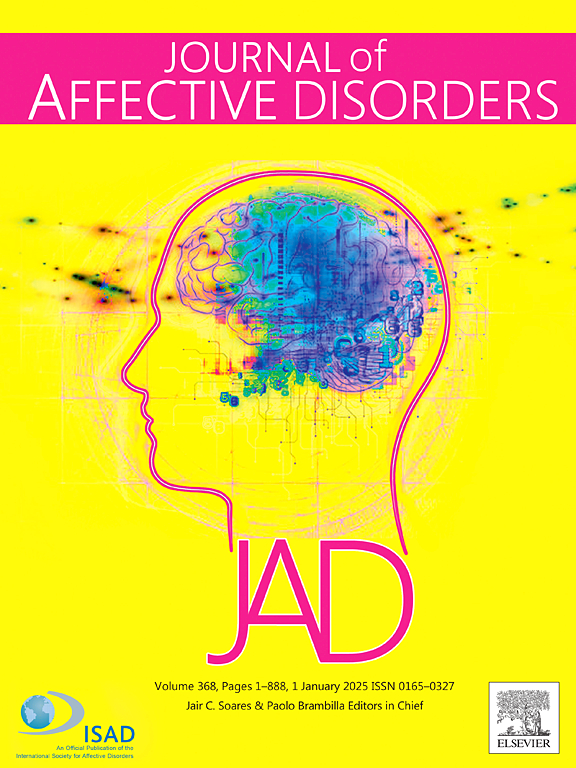The effect of non-invasive brain stimulation in reducing anhedonia and apathy in major depressive disorder and schizophrenia: A meta-analysis
IF 4.9
2区 医学
Q1 CLINICAL NEUROLOGY
引用次数: 0
Abstract
Background
Anhedonia and apathy are core symptoms of Major Depressive Disorder (MDD) and schizophrenia, and respectively refer to deficit in reward processing and motivation. Emerging evidence indicates noninvasive brain stimulation (NIBS) such as transcranial magnetic stimulation (TMS) and transcranial direct current stimulation (tDCS) may be effective in treating anhedonia and apathy.
Objective
To quantitatively synthesize existing literature on the efficacy of TMS and tDCS in alleviating anhedonia and apathy among individuals with MDD and schizophrenia.
Methods
This meta-analysis synthesized findings from 22 previous studies including adults with MDD and schizophrenia (total N = 1258, female% = 43.73 %, age = 37.33 ± 8.35 years, PROSPERO registration no. CRD42023426223). A multilevel random-effect model was adopted to compute pooled effect size and heterogeneity across studies.
Results
NIBS shows an overall significant effect in reducing anhedonia and apathy among individuals with MDD and schizophrenia, which is more robust for unilateral excitatory stimulation over the left DLPFC and for RCT studies. While TMS shows no specific effect in reducing anhedonia, it shows a significant effect in decreasing apathy, with both effects dependent on the outcome measurement method. Limited evidence shows significant overall effect of tDCS in reducing anhedonia and apathy, but its specific effect on apathy is inconclusive.
Conclusions
NIBS methods show overall modest effects in reducing anhedonia and apathy in MDD and schizophrenia, but the heterogeneity is high that may result from limited study number and methodological variations such as stimulation location. More studies need to be conducted particularly for tDCS intervention, and using task and specific measures of anhedonia and apathy.
非侵入性脑刺激对减轻重度抑郁症和精神分裂症患者快感缺乏和冷漠的影响:一项荟萃分析。
背景:快感缺失和冷漠是重度抑郁症(MDD)和精神分裂症的核心症状,分别指奖励加工缺陷和动机缺陷。越来越多的证据表明,非侵入性脑刺激(NIBS)如经颅磁刺激(TMS)和经颅直流电刺激(tDCS)可能有效治疗快感缺乏和冷漠。目的:定量综合现有文献对经颅磁刺激和经颅磁刺激缓解重度抑郁症和精神分裂症患者快感缺乏和冷漠的疗效。合成方法:本荟萃分析发现22之前的研究包括与MDD和成人精神分裂症(总N = 1258,女性% = 43.73 %,年龄 = 37.33 ±8.35 年,普洛斯彼罗没有注册。CRD42023426223)。采用多水平随机效应模型计算各研究的合并效应大小和异质性。结果:NIBS在减少重度抑郁症和精神分裂症患者的快感缺乏症和冷漠方面显示出总体上显著的效果,这在左侧DLPFC的单侧兴奋性刺激和RCT研究中更为明显。虽然经颅磁刺激在减少快感缺乏症方面没有具体的效果,但在减少冷漠方面却有显著的效果,这两种效果都取决于结果测量方法。有限的证据表明,tDCS在减少快感缺乏症和冷漠方面有显著的总体效果,但其对冷漠的具体效果尚无定论。结论:NIBS方法在减少重度抑郁症和精神分裂症患者的快感缺乏和冷漠方面显示出总体适度的效果,但异质性很高,这可能是由于研究数量有限和方法差异(如刺激位置)造成的。需要进行更多的研究,特别是tDCS干预,并使用任务和特定的快感缺乏和冷漠措施。
本文章由计算机程序翻译,如有差异,请以英文原文为准。
求助全文
约1分钟内获得全文
求助全文
来源期刊

Journal of affective disorders
医学-精神病学
CiteScore
10.90
自引率
6.10%
发文量
1319
审稿时长
9.3 weeks
期刊介绍:
The Journal of Affective Disorders publishes papers concerned with affective disorders in the widest sense: depression, mania, mood spectrum, emotions and personality, anxiety and stress. It is interdisciplinary and aims to bring together different approaches for a diverse readership. Top quality papers will be accepted dealing with any aspect of affective disorders, including neuroimaging, cognitive neurosciences, genetics, molecular biology, experimental and clinical neurosciences, pharmacology, neuroimmunoendocrinology, intervention and treatment trials.
 求助内容:
求助内容: 应助结果提醒方式:
应助结果提醒方式:


